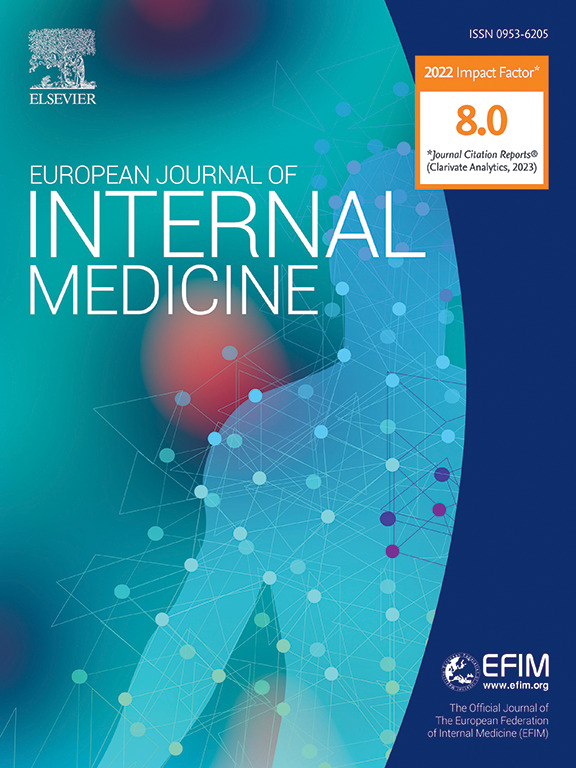Association of non-cardiac comorbidities and sex with long-term Re-hospitalization for heart failure
IF 5.9
2区 医学
Q1 MEDICINE, GENERAL & INTERNAL
引用次数: 0
Abstract
Heart failure (HF) often coexists with non-cardiac comorbidities (NCC), but their association with long-term HF re-hospitalizations is not defined.
Using the Lombardy Regional Health Database, that includes >10 million residents, we assessed the risk of re-hospitalization for HF after first HF discharge as a function of NCC, employing age- and sex-adjusted Cox proportional-hazard models. Kaplan Meier curves for HF re-hospitalizations were stratified for number of NCC. End of follow-up was June 30th 2021.
Between January 1st 2015 to December 31st 2019, 88,528 consecutive patients were discharged from hospital with a primary diagnosis of HF; over 42.8 ± 18.3 months follow-up, 79,533 HF re-hospitalizations occurred (32.94/100 patient/year). Number of NCC, age, and male sex were significantly associated with re-hospitalization risk. Compared to those without NCC, females and males with >4 NCC had a 3.08 (CI 2.73–3.47) and a 2.62 (CI 2.39–2.87) fold higher risk, respectively. Risk of all-cause death increased with number of NCC (hazard ratio (HR): 1.42 (1.38–1.46) for HF patients with 1–2 NCC, HR: 1.90 (1.82–1.98) for patients with 3–4 NCC, HR: 2.20 (2.01–2.40) for those with HF and >4 NCC), as it did the number of days spent in hospital because of HF (from 19.91±19.25 for patients without NCC to 45.35±33.00 days for those with >4 NCC, p < 0.0001).
In conclusion, this study shows that in patients hospitalized with HF, HF re-hospitalizations, all-cause mortality, and time spent in hospital increased with number of NCC. NCC associates with a worse clinical trajectory in patients with HF.
非心脏病合并症和性别与心力衰竭长期再住院的关系
心力衰竭(HF)常常与非心脏病合并症(NCC)同时存在,但它们与长期HF再住院的关系尚未明确。我们利用伦巴第地区健康数据库(其中包括超过 1,000 万居民),采用年龄和性别调整后的 Cox 比例危险模型,评估了首次高频出院后因高频再次住院的风险与 NCC 的关系。心房颤动再次住院的卡普兰-梅耶尔曲线根据 NCC 的数量进行分层。随访结束日期为 2021 年 6 月 30 日。在2015年1月1日至2019年12月31日期间,有88528名患者连续出院,主要诊断为心房颤动;在42.8±18.3个月的随访期间,发生了79533次心房颤动再住院(32.94/100名患者/年)。NCC数量、年龄和男性性别与再住院风险显著相关。与没有 NCC 的患者相比,女性和男性 NCC >4 的风险分别高出 3.08 (CI 2.73-3.47) 倍和 2.62 (CI 2.39-2.87) 倍。全因死亡风险随 NCC 数量的增加而增加(危险比 (HR):1-2 NCC 的 HF 患者为 1.42(1.38-1.46),3-4 NCC 患者为 1.90(1.82-1.98),HR:2.20(2.01-2.HR:1.90(1.82-1.98),NCC:3-4 例 NCC 患者 HR:2.20(2.01-2.40),HF>4 例 NCC 患者 HR:2.20(2.01-2.40)),因为 HF 而住院的天数也是如此(从无 NCC 患者的 19.91±19.25 天到 NCC>4 例患者的 45.35±33.00 天,P<0.0001)。总之,本研究表明,在因心房颤动住院的患者中,心房颤动再住院率、全因死亡率和住院时间随 NCC 数量的增加而增加。NCC与心房颤动患者更糟糕的临床轨迹有关。
本文章由计算机程序翻译,如有差异,请以英文原文为准。
求助全文
约1分钟内获得全文
求助全文
来源期刊
CiteScore
9.60
自引率
6.20%
发文量
364
审稿时长
20 days
期刊介绍:
The European Journal of Internal Medicine serves as the official journal of the European Federation of Internal Medicine and is the primary scientific reference for European academic and non-academic internists. It is dedicated to advancing science and practice in internal medicine across Europe. The journal publishes original articles, editorials, reviews, internal medicine flashcards, and other relevant information in the field. Both translational medicine and clinical studies are emphasized. EJIM aspires to be a leading platform for excellent clinical studies, with a focus on enhancing the quality of healthcare in European hospitals.

 求助内容:
求助内容: 应助结果提醒方式:
应助结果提醒方式:


